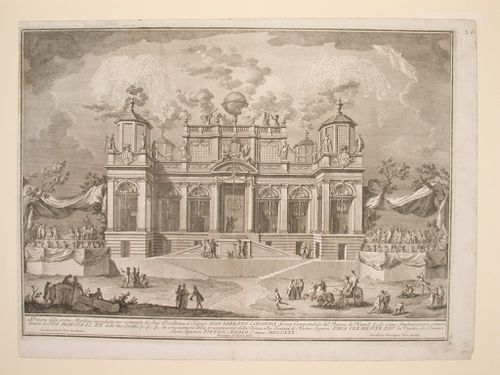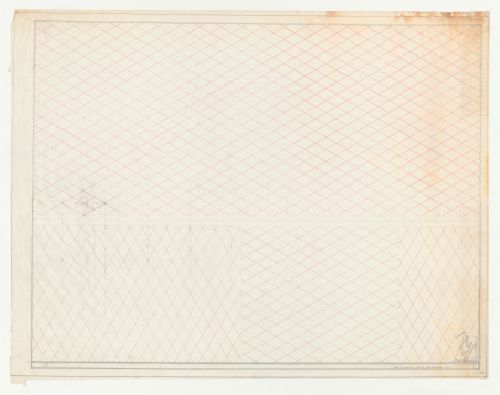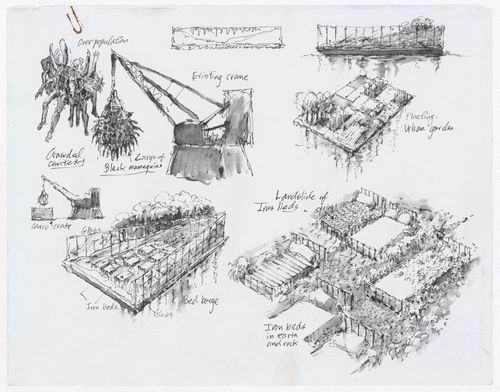ARCH286690
Description:
This item contains harmful materials including violent imagery. The drawing illustrates the discrete elements of an exhibition involving several large-scale installations. One of these installations shows a crane on which a net filled with mannequins is suspended; the mannequins are soaked in oil, in the words of the designers, to represent the impacts of oil spills on the global population. This image, however, suggests violence beyond environmental disasters.
circa 1999-2000
Drawings for two installations for the exhibition on James Wines at the Venice Biennale
Actions:
ARCH286690
Description:
This item contains harmful materials including violent imagery. The drawing illustrates the discrete elements of an exhibition involving several large-scale installations. One of these installations shows a crane on which a net filled with mannequins is suspended; the mannequins are soaked in oil, in the words of the designers, to represent the impacts of oil spills on the global population. This image, however, suggests violence beyond environmental disasters.
DR1988:0437:041
Description:
- This etching for a fireworks construction or macchina is in the form of a pavilion, with stands for musicians on either side. The lower level of the macchina represents a series of fish stalls and the architecture is deliberately rusticated, with cracks in the masonry and vines growing on the arches. The upper level consists of one large and four small canopies held up with columns wrapped with wreaths.
temporary architecture
printed 1770
Etching of Posi's design for the "seconda macchina" of 1770
Actions:
DR1988:0437:041
Description:
- This etching for a fireworks construction or macchina is in the form of a pavilion, with stands for musicians on either side. The lower level of the macchina represents a series of fish stalls and the architecture is deliberately rusticated, with cracks in the masonry and vines growing on the arches. The upper level consists of one large and four small canopies held up with columns wrapped with wreaths.
temporary architecture
DR1987:0529 R/V
Description:
- This unused sheet was probably prepared for a drawing for Wayfarers' Chapel, Palos Verdes, California. The verso of the sheet includes four discrete grids whose units each represent an equilateral parallelgram measuring 4'8" along the side and 8'0 31/32" in length. These measurements are described by Lloyd Wright in the architect's statement as the grid unit for Wayfarers' Chapel (DR1987:0869:011:009).
architecture
between 1946 and 1950
Wayfarers' Chapel, Palos Verdes, California: Unused sheet ruled with guide line for orthographic drawings and measurements for a typical grid unit
Actions:
DR1987:0529 R/V
Description:
- This unused sheet was probably prepared for a drawing for Wayfarers' Chapel, Palos Verdes, California. The verso of the sheet includes four discrete grids whose units each represent an equilateral parallelgram measuring 4'8" along the side and 8'0 31/32" in length. These measurements are described by Lloyd Wright in the architect's statement as the grid unit for Wayfarers' Chapel (DR1987:0869:011:009).
architecture
archives
Level of archival description:
Fonds
Ross & Macdonald fonds
AP013
Synopsis:
The Ross & Macdonald fonds is comprised of documents concerning the work of six successive architectural firms: Ross & MacFarlane (1905-1912), Ross & Macdonald (1913-1944), Ross & Ross (1944-1946), Ross, Patterson, Townsend & Heughan (1946-1950), Ross, Patterson, Townsend & Fish (1950-1958), and Ross, Fish, Duschenes & Barrett (1958-1976). The greatest concentration of work was produced in Montreal where each of the firms maintained their head office, but there were also a large number of works executed in New Brunswick and Nova Scotia. The fonds contains 27 884 drawings (24 294 originals plus 3 590 reproductions), 236 photographs, and 18.6 metres of textual documents.
1902-1982
Ross & Macdonald fonds
Actions:
AP013
Synopsis:
The Ross & Macdonald fonds is comprised of documents concerning the work of six successive architectural firms: Ross & MacFarlane (1905-1912), Ross & Macdonald (1913-1944), Ross & Ross (1944-1946), Ross, Patterson, Townsend & Heughan (1946-1950), Ross, Patterson, Townsend & Fish (1950-1958), and Ross, Fish, Duschenes & Barrett (1958-1976). The greatest concentration of work was produced in Montreal where each of the firms maintained their head office, but there were also a large number of works executed in New Brunswick and Nova Scotia. The fonds contains 27 884 drawings (24 294 originals plus 3 590 reproductions), 236 photographs, and 18.6 metres of textual documents.
archives
Level of archival description:
Fonds
1902-1982
Series
AP177.S2
Description:
This series contains additional CAD and 3D modeling work made by David Ruy for RUR Architecture in order to achieve the design of architectural elements of the Kansai-kan National Diet Library competition. Files are identified as parts or elements of the building such as “upper slab”, “pig” (term used for the theater), “topo[graphical] lines”, “spiral” (a part of the store), “diagram”, “catwalks”, “ramps”, etc. File names are similar to the ones found in AP177.S1, which could indicate that the files represent different versions of the digital drawings. Under the directory FINAL PLANS, file names suggest digital drawings presenting more substantial parts of the building such as “conference level”, “plan”, and “hanging volume”. Files were created using form*Z and Alias and were saved in FMZ, DXF and OBJ formats. Series also includes, in the “scans” directory, digitized images, in JPEG format, of manual drawings of the upper and lower slab with topographical lines, the spiral and the placing of support points.
1996-2015
David Ruy digital working files
Actions:
AP177.S2
Description:
This series contains additional CAD and 3D modeling work made by David Ruy for RUR Architecture in order to achieve the design of architectural elements of the Kansai-kan National Diet Library competition. Files are identified as parts or elements of the building such as “upper slab”, “pig” (term used for the theater), “topo[graphical] lines”, “spiral” (a part of the store), “diagram”, “catwalks”, “ramps”, etc. File names are similar to the ones found in AP177.S1, which could indicate that the files represent different versions of the digital drawings. Under the directory FINAL PLANS, file names suggest digital drawings presenting more substantial parts of the building such as “conference level”, “plan”, and “hanging volume”. Files were created using form*Z and Alias and were saved in FMZ, DXF and OBJ formats. Series also includes, in the “scans” directory, digitized images, in JPEG format, of manual drawings of the upper and lower slab with topographical lines, the spiral and the placing of support points.
Series
1996-2015
Project
AP178.S1.1983.PR01
Description:
This project series documents the Reconstrução da Igreja Madre de Salemi, the Piazza Alicia and the Recuperação do Plano Cascio in Salemi, Italy. While the records were held in the office’s archives this project was assigned the number [7]/80. The office assigned the dates 1983-1999 for this project. The reconstruction of the mother Church of Salemi, the construction of the Piazza Alicia, and the rehabilitation of Plano Cascio was part of an urban renewal for Salemi. In 1968, an earthquake destroyed the Igreja Madre de Salemi and damaged the area. The church was never rebuilt. In 1982, Roberto Collovà and Siza we're chosen by the Curia of Mazara del Vallo for the reconstruction of the church. Instead of rebuilding it, the architects decided to use the ruins to create something new that would represent the spirit of the church and the memory of the earthquake. Documenting this project are plans, project documentation, and correspondence. Photographic materials document construction work and the model.
1984-1992
Reconstrução da Igreja Madre de Salemi [Reconstruction of the Mother Church of Salemi], Salemi, Italy (1983-1999)
Actions:
AP178.S1.1983.PR01
Description:
This project series documents the Reconstrução da Igreja Madre de Salemi, the Piazza Alicia and the Recuperação do Plano Cascio in Salemi, Italy. While the records were held in the office’s archives this project was assigned the number [7]/80. The office assigned the dates 1983-1999 for this project. The reconstruction of the mother Church of Salemi, the construction of the Piazza Alicia, and the rehabilitation of Plano Cascio was part of an urban renewal for Salemi. In 1968, an earthquake destroyed the Igreja Madre de Salemi and damaged the area. The church was never rebuilt. In 1982, Roberto Collovà and Siza we're chosen by the Curia of Mazara del Vallo for the reconstruction of the church. Instead of rebuilding it, the architects decided to use the ruins to create something new that would represent the spirit of the church and the memory of the earthquake. Documenting this project are plans, project documentation, and correspondence. Photographic materials document construction work and the model.
Project
1984-1992
textual records
DR1988:0017:001-003
Description:
Part of a miscellaneous group of visual and textual documents collected by Oswald Mathais Ungers, apparently to represent the work of artists/architects in Die gläserne Kette. In this letter Hansen describes a theoretical project, "Der Bauhof", which is typical of the utopian concerns of the members (transl. in Whyte, 67-69). Text signed "Antischmitz", pseudonym of Hansen for Die gläserne Kette correspondence.
1920
The Building Centre: Reprographic copy of a letter for Die gläserne Kette
Actions:
DR1988:0017:001-003
Description:
Part of a miscellaneous group of visual and textual documents collected by Oswald Mathais Ungers, apparently to represent the work of artists/architects in Die gläserne Kette. In this letter Hansen describes a theoretical project, "Der Bauhof", which is typical of the utopian concerns of the members (transl. in Whyte, 67-69). Text signed "Antischmitz", pseudonym of Hansen for Die gläserne Kette correspondence.
textual records
1920
archives
Level of archival description:
Fonds
Kaiman Lee fonds
AP222
Synopsis:
The Kaiman Lee fonds, circa 1965 – 2006, documents the professional and academic career of Dr. Kaiman Lee. The material in the fonds also represents the publishing activities of the Environmental Design and Research Center, and the Center for Environmental Research, both based in Boston. The fonds also covers Lee’s academic pursuits as a student and lecturer. The fonds also contains computer parts related to the ARK Two computer-aided design system which Lee worked on during his time at the Boston-based firm Perry, Dean and Stewart Architects. The records within the fonds largely consists of photographic materials, publications, and artefacts.
circa 1965 - 2006
Kaiman Lee fonds
Actions:
AP222
Synopsis:
The Kaiman Lee fonds, circa 1965 – 2006, documents the professional and academic career of Dr. Kaiman Lee. The material in the fonds also represents the publishing activities of the Environmental Design and Research Center, and the Center for Environmental Research, both based in Boston. The fonds also covers Lee’s academic pursuits as a student and lecturer. The fonds also contains computer parts related to the ARK Two computer-aided design system which Lee worked on during his time at the Boston-based firm Perry, Dean and Stewart Architects. The records within the fonds largely consists of photographic materials, publications, and artefacts.
archives
Level of archival description:
Fonds
circa 1965 - 2006
ARCH286669
Description:
This item contains harmful materials including violent and racist imagery. The drawing illustrates the discrete elements of an exhibition involving several large-scale installations. One of these installations shows a crane on which a net filled with mannequins is suspended; the mannequins are painted black, in the words of the designers, to represent the impacts of oil spills on the global population. This image, however, suggests violence beyond environmental disasters.
circa 1999-2000
Drawing for the exhibition on James Wines at the Venice Biennale
Actions:
ARCH286669
Description:
This item contains harmful materials including violent and racist imagery. The drawing illustrates the discrete elements of an exhibition involving several large-scale installations. One of these installations shows a crane on which a net filled with mannequins is suspended; the mannequins are painted black, in the words of the designers, to represent the impacts of oil spills on the global population. This image, however, suggests violence beyond environmental disasters.
DR1984:0705
Description:
- The competition drawing by Hannes Meyer and Hans Wittwer for the League of Nations Building in Geneva (DR1984:0705) is similar to the competition drawing shown in photograph PH1984:0004. Both objects show axonometric representations for the building. The photograph lacks the toboggan-like element within the tower and the illegible inscription at the lower right is apparently different from the illegible inscription at the lower right of the drawing.
architecture
1926-1927
Competition Design for the League of Nations Building in Geneva
Actions:
DR1984:0705
Description:
- The competition drawing by Hannes Meyer and Hans Wittwer for the League of Nations Building in Geneva (DR1984:0705) is similar to the competition drawing shown in photograph PH1984:0004. Both objects show axonometric representations for the building. The photograph lacks the toboggan-like element within the tower and the illegible inscription at the lower right is apparently different from the illegible inscription at the lower right of the drawing.
architecture




